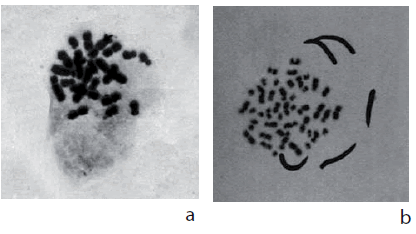Services on Demand
Journal
Article
Indicators
-
 Cited by SciELO
Cited by SciELO
Related links
-
 Similars in
SciELO
Similars in
SciELO  uBio
uBio
Share
BAG. Journal of basic and applied genetics
On-line version ISSN 1852-6233
BAG, J. basic appl. genet. vol.21 no.1 Ciudad Autónoma de Buenos Aires Jan./June 2010
ARTÍCULOS ORIGINALES
A case of mosaicism in the germinal line of Odontophrynus americanus (Dùmeril et Bibron. 1841)
Salas1, Nancy and Martino1, Adolfo
1Ecología-Educación Ambiental, Departamento de Ciencias Naturales, Facultad de Ciencias Exactas, Físico-Químicas y Naturales, Universidad Nacional de Río Cuarto. Ruta Nacional N° 8 - km 601, (X5804BYA) Río Cuarto, Argentina. nsalas@exa.unrc.edu.ar.
Correspondence to: Nancy Salas, nsalas@exa.unrc.edu.ar.
The cytogenetic studies have special importance in the zoological research because by means of karyotype analysis they contribute to the identifi cation of different entities, facilitate the evaluation of the proximity or relationship degree among certain species and fi nally they contribute with fundamental data to the phylogenetic assessment (Schmid et al., 1985; Zampieri et al., 2004). The occurrence of polyploidy in different anuran families that appear as cryptic species highlights the importance of the cytogenetic study at the population level (Valetti et al., 2009).
Key words: Mosaicism; Odontophrynus americanus.
The objective of this work was to report the presence of cells of different ploidy in a population of Odontophrynus americanus.
The cytogenetic study was carried out in
three males (ALM 249-251) of the Odontophrynus species captured at Merlo village , San Luis province, Argentina (32° 21´S, 65° 02´W). The village is located in the western side of the Sierra de Comechingones at 850 meters above sea level.
Mitotic metaphases were obtained from testicles after in vivo colchicine treatment according to conventional protocols. All the techniques employed for the cell preparations, hypotonic treatment, fixation and staining with Giemsa were applied to all the specimens as described in Schmid (1978).
Photographs were obtained by using an Axiophot Microscope (Carl Zeiss) with Cannon Powershot G6 Digital Camera and Zoom Browser EX.
The cytogenetic study performed in testicular tissues of the three studied males showed the presence of cells with different ploidy. Two germinal lines were observed: diploid (2n = 22) and tetraploid (4n = 44), with frequencies of 35,1 % for diploid cells and 64.9 % for tetraploid cells (Figure 1a, b, Figure 2a, b and Table I).

Figure 1. Diploid metaphase, 2n = 22 (a) and tetraploid metaphase 4n = 44 (b), both from testicle cells of Odontophrynus americanus. Giemsa stain.

Figure 2. Karyotype of each germinal line (a) 2n = 22 and (b) 4n = 44 both from testicle cells of Odontophrynus americanus. Giemsa stain.
Table I. Cell number with different ploidy in testicle tissue of Odontophrynus americanus from Merlo village, San Luis Province, Argentine.

In spite of the existence of several polyploid anurans species, the mosaicism phenomenon has only been reported for the Bufo viridis complex in the one which the tetraploid species Bufo pseudoraddei baturae presented cells of different ploidy (diploid, triploid and tetraploid) (Stöck et al., 1999). The mosaicism observed in the germinal line of O. americanus population from Merlo village of San Luis Province, is a fi nding particularly interesting that deserves to continue investigating.
ACKNOWLEDGEMENTS
We thank to Lucio Zavala Gallo for the samples provision. This study was supported by a grant from Secretaría de Ciencia y Técnica of the Universidad Nacional de Río Cuarto (SECyT-UNRC) - 18/C350.
REFERENCES
1. SCHMID, M. (1978). Chromosome banding in Amphibia I. Constitutive heterochromatin and nucleolus organizer regions in Bufo and Hyla. Chromosoma, 66: 381-388. [ Links ]
2. SCHMID, M., HAAF, T., & CHEMPP, W. (1985). Chromosome banding in Amphibia IX. The polyploid karyotypes of Odontophrynus americanus and Ceratophrys ornata (Anura, Leptodactylidae). Chromosoma, 91:172-182. [ Links ]
3. STÖCK, M., SCHMID, M., STEINLEIN, C., & GROSSE, W.R. (1999). Mosaicism in triploid specimens of Bufo viridis complex in the Karakoram with examination of calls, morphology and taxonomic conclusions. Ital. J. Zool., 66: 215-232. [ Links ]
4. VALETTI, J., SALAS, NANCY E. & MARTINO, A. (2009). A new polyploid species of Pleurodema (Anura: Leiuperidae) from Sierra de Comechingones, Córdoba, Argentina and redescription of Pleurodema kriegi (Müller, 1926). Zootaxa, 2073:1-21. [ Links ]
5. ZAMPIERI SILVA, A.P., GARCIA, P.C.A., MARTINS, V.G., BACCI, M., & KASAHARA, S. (2004). Chromosomal and molecular analysis of Leptodactylus gracilis gracilis, L. gracilis delattini, and L. plaumanni (Anura, Leptodactylidae): taxonomic implications, Amphibia-Reptilia, 25(2):185-196. [ Links ]














